Year 3 Learning from Home Week 8
Week beginning - 1 June
Welcome to Week 8 of Learning from Home.
Organisational Skills:
Complete the following tasks in your homework book.
Try to complete one task from each section per day.
Make sure you always date your work.
You may also choose to write the learning intention at the top of the page.
Please ensure you use neat handwriting when completing an activity.
Underline the activity once completed.
Please write neatly, using a grey lead pencil.
Reading
Learning Intentions:
We are building our reading stamina.
We are learning to infer meaning from poetry.
We are learning how to infer when reading.
Tasks:
- Each day, read a JRB (Just Right Book) for at least 30 minutes to build your reading stamina. *Remember to log your reading in your homework book recording the date, title, author, genre and rating.*
(30 minutes)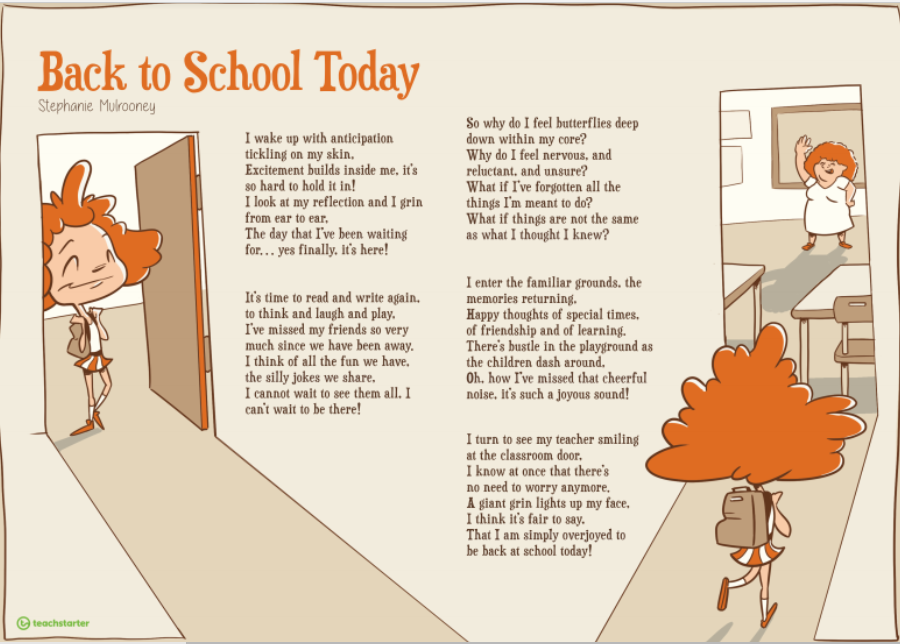
- Use clues from the poem, ‘Back to School Today’, as well as your background knowledge, to answer the questions below.
Remember to answer questions in full sentences.
- Why does the girl ‘grin from ear to ear’? (paragraph 1)
- Why does the girl ‘feel butterflies deep down’? (paragraph 3)
- What are the ‘familiar grounds’? (paragraph 4)
- What is the ‘bustle in the playground’? (paragraph 4)
- Why is the girl happy to be back at school again?
- Why does the girl say, ‘there’s no need to worry anymore’, when she sees her teacher? (paragraph 5)
Click here to check your answers, using a red pencil.
- Why does the girl ‘grin from ear to ear’? (paragraph 1)
- Shared Class novel:
Click here and read Out of Time: Lost on the Titanic book 3.
Answer the following questions using full sentences.
Give evidence from the text to support your answers.
(45 minutes)
- How do you know that Allie cares about Ruth? (p.4)
- How would you describe Max’s inside character traits? (p.4-5)
- Why does Vic blink? (p.11)
- Why does Allie shiver? (p.12)
- How do you know that Atlas is from the future? (p.17)
- Why doesn’t Luna jump up when she sees Juniper? (p.29)
- How do you know that Allie cares about Ruth? (p.4)
Writing
Learning Intentions:
We are learning to plan our narratives using a graphic organiser.
We are learning to write a narrative.
Tasks:
- Click here to open a blank Story Mountain Planner.
Complete this template, including the setting you drew from Week 5 and the character profile you wrote in Week 7.
Remember to include:
The Beginning
The beginning of your narrative should introduce your main character and setting.
You will need to add descriptive language for the setting and be sure to have a ‘sizzling’ or exciting opening sentence to grab the reader’s attention.
The Build-up
What happens in your story?
What will the opening events look like?
Introduce other characters and begin to think about how you will create and build up to the main problem or challenge in your story.
The Problem
What goes wrong in your story?
What challenge does the main character have to overcome?
How will they overcome it?
The Resolution
How does your main character solve the main problem?
Did they need help?
What steps did they take to solve the problem/challenge in your story?
The Ending
How does the story end?
Is it a happy or sad ending?
Surprise endings are good. Try to leave your audience wanting more.
(45 minutes)
- Creative Writing
Choosing ONE of the following pictures below, create a word splash responding to the picture using the 5 senses.
Write a story using the interesting adjectives you used in your word splash.
(40 minutes)


Spelling
Learning Intentions:
We are learning to use the CUPS editing strategy to revise our work.
We are learning to revise our use of compound words.
We are learning to find words within words.
Tasks:
- Below is the CUPS editing strategy that will help you when editing and revising your work.
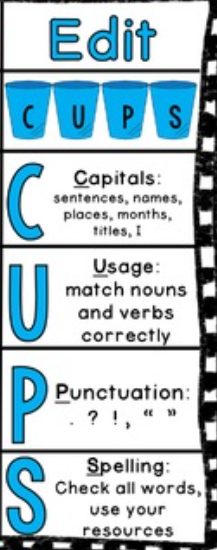
Look at the paragraph below:
yesterday i had my session on a Webex meting talkng to my teecher and seeing my frends their are only twelv students from my clas in my groop we see eech otha and we talk too the teecher it is so interesting seeing the bakgrnds beahind my frends wee shere our worc ask qestions and shere noos we hav also shared joks and wawn funy hats
Copy this into your homework book, correcting any misspelled words and add any missing full stops, commas and capital letters.
(30 minutes)
Click here to check your answers, using a red pencil. - Compound Words
Compound words are formed when two or more words are joined together to create a new word that has an entirely new meaning.
For example, “sun” and “flower” are two different words, but when joined together, they form another word, sunflower.
Think of 4 compound words and illustrate them, as in the example below.
(30 minutes)
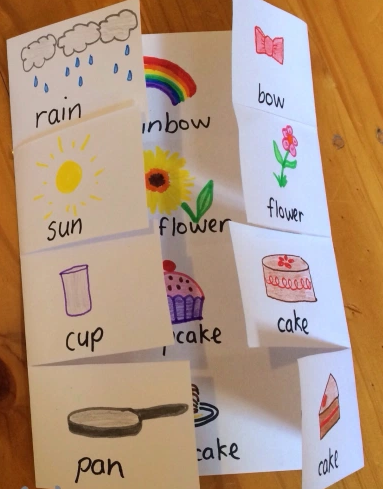
Click here for a guide on how to make the booklet with your own compound words. - Words Within Words
How many words can you make from the letters in the word TEACHER?
You must use only the letters within this word, and letters can not be doubled up (there is only one ‘T’ so can only be used once per word).
Letters can be used in any order.
The words must be from the English language and they can not be proper nouns (names, places, brands).
How many can you get?
0-10 words = good
11-20 words = very good
21-30 words = excellent
31-40 = awesome
40+ = Teacher (Genius!)
(15 minutes)
Handwriting
Learning Intention:
We are learning to use neat and tidy handwriting.
Tasks:
- Practise writing the letter ‘E’ by copying the examples below into your homework book.
(30 minutes)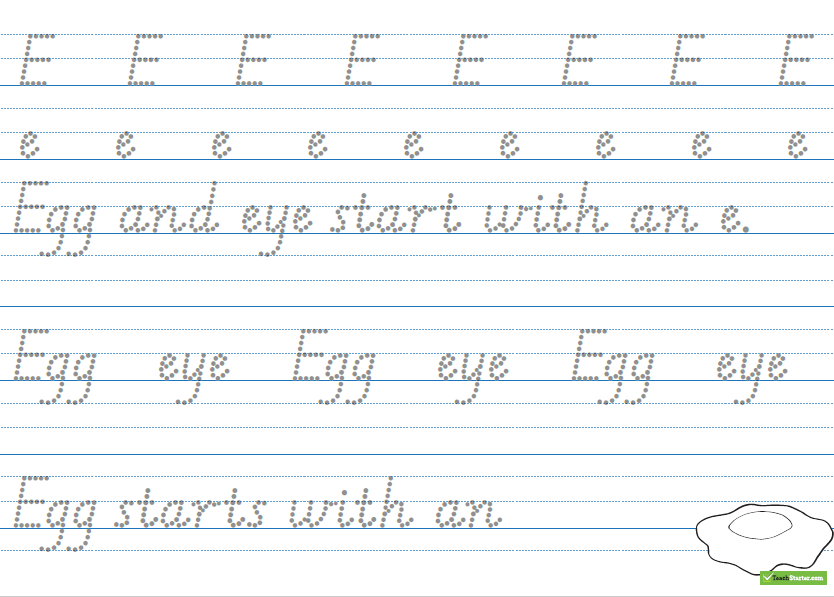
Maths
Learning Intentions:
We are completing the shape pretest on Essential Assessment.
We are using fluency games to practise our addition.
We are learning to solve worded problems using the most efficient strategy.
We are using skip counting to revise our counting.
Tasks:
- My Numeracy: Log in to Essential Assessment and complete the Shape Pretest.
Once you have completed your Pretest on Shape, continue to work through your My Numeracy tasks.
Make sure you complete your tasks in Addition and Time first then complete the Place Value and General tasks.
The tasks assigned are skills you need to develop based on your assessments, so do your best!
(60 minutes) - Fluency game: Play Greedy Pig. This game will help to build your addition skills.
You will need: timer, dice, lined homework book, pencil
To play with a partner:
Set your timer for 5 minutes, then do paper, scissors, rock to work out who will roll first.
The winner rolls the dice first and writes down the number in their lined homework book.
The second player does the same.
On your second turn, add the number that you roll to your first number.
For example, if player one rolled a 5 on their first turn and a 3 on their second turn, they would add these two numbers together. Their total is now 8.
Take turns rolling the dice and adding the new number to your total.
If you roll a 1, your total score goes back to 0 and you have to start again.
At the end of the 5 minutes, the player with the most points is the winner.
To play by yourself:
Set the timer for 2 minutes.
Roll the dice and write down the number in your lined homework book.
On your second turn, add the number that you roll to your first number.
For example, if you rolled a 5 on your first turn and a 3 on your second turn, you would add these two numbers together. Your total is now 8.
Continue rolling the dice and adding the new number to your total.
If you roll a 1, your total score goes back to 0 and you have to start again.
At the end of the 2 minutes stop. That will be your score for round 1.
Play another few rounds to see if you can beat your score.
(10-15 minutes) - Worded Problems
Solve the following worded problems by writing out both the question and answer into your homework book.
Included below is a guide on how to solve worded problems.
After you answer each of the questions below, write down which addition strategy you used (doubles, split, jump etc.) and explain how it helped you to solve the problem.
Draw a number line to show your working out if using the jump strategy.
Mr Butler practised his guitar for 48 minutes before school and 34 minutes after school. How many minutes did he practise altogether?
Mr Palmer-Leeraar received $15 for his birthday. He added this to his savings account which has $53. How much does Mr Palmer-Leeraar have now?
Mrs Morris and Mrs Roberts held a lemonade stall over the weekend. They sold 25 cups on Saturday and 19 cups on Sunday. How many cups did they sell altogether?
Mrs Roberts had 380 legos, then she found another 57 of them. How many legos does she have now?
Mr Butler baked 35 muffins on Friday. On Saturday he baked 56 muffins. On Sunday he baked 182 muffins. How many muffins did Mr Butler bake over three days?
Mr Palmer-Leeraar has 140 crayons. Mrs Morris has 290 crayons. Mrs Roberts has 7 crayons. How many crayons do they have altogether?
Mr Butler has 639 counters. Mrs Roberts has 504 counters. How many counters do Mr Butler and Mrs Roberts have altogether?
Mrs Morris has 85 peanuts. Mr Palmer-Leeraar has 48 more than Mrs Morris. How many peanuts do Mrs Morris and Mr Palmer-Leeraar have altogether?
(45 minutes) - Skip Counting Revision!
Copy and complete the following skip counting patterns in your homework book.
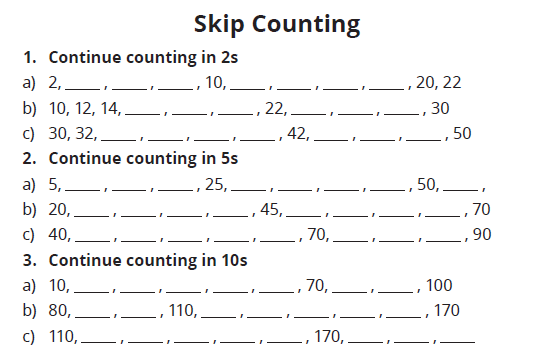
Challenge: Once you have completed the above, have a go at creating your own skip counting patterns. Try to create 3 unique skip counting patterns (include 15 numbers for each pattern!).
(30 minutes)
Click here to check your Maths answers, using a red pencil.
Inquiry
Learning Intention:
To use our understanding of Australia’s different climate zones to create a fictional animal or plant.
Task:
A new and exciting discovery has just been made…
In the dry and dusty depths of the Australian outback,
in the wet and wild forest of the Northern Territory,
in the far-flung corners of the Dandenong Ranges,
scientists have just discovered a fascinating new find...
You are one of the scientists who have made this discovery and you must now present your findings to the world!
Is it a plant or animal?
What does it look like?
How has it adapted to survive in the climate zone where you found it?
Using your knowledge of climate zones and the animals and plants that live in them - and maybe some extra research - design a NEW plant or animal.
Your task is to create a new Australian animal that lives in either a tropical, temperate or arid climate zone.
You will need to draw it and colour it in.
You will then need to write a short description stating;
its name
where it lives
what it eats (if it’s an animal)
how it survives in its habitat
An example is included below:
The Polaris Bear.
This exciting new creature has been found in the frozen deserts of the Arctic.
Standing 3 metres tall, with paws as big as car tyres, this bear is a wild and ferocious beast.
It hunts rabbits, foxes and seals and leaves destruction wherever it goes.
It is perfectly adapted to suit its harsh environment; it uses its white fur to blend in to the wintery landscape.
The thick fur protects the hunter from the cold weather.
The oversized paws help them to walk silently on the soft snow and enable them to swim at great speed in the freezing water.
Wellbeing
Resilience, Rights and Respectful Relationships ‘Positive Coping’
Learning Intentions:
To understand that different problems need different solutions.
To identify a range of strategies and solutions to use when solving problems.
Task:
Read through the scenarios shown below. In your homework book, have a go at answering each of the questions.
(40 minutes)
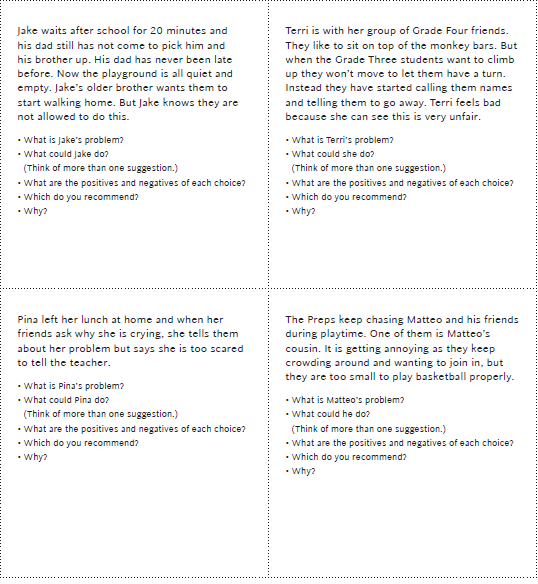
Specialists
Click here for specialist program
© Copyright Laburnum Primary School
